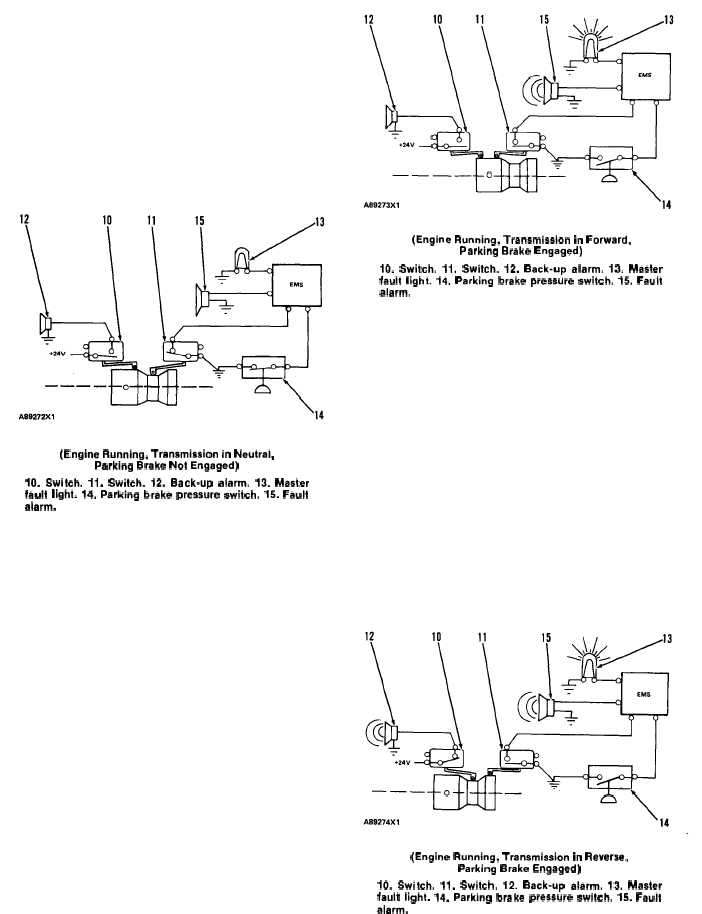TM 5-3805-258-24-1
P O W E R T R A I N
T R A N S M I S S I O N
N E U T R A L I Z E R
G R O UP
S Y S T E M S O P E R A T I O N
If the transmission is engaged in either FOR-
WARD or REVERSE, levers (4) will come in con-
tact with cam (7). The force of spring (8) causes cam
(7) to move when contact is made with the levers.
Since cam (7) is connected to the direction selection
spool by rod (5), the direction selection spool will also
move. The direction selection spool is moved from the
FORWARD or REVERSE position, to the NEU-
TRAL position.
With the transmission in NEUTRAL, switches (10)
and (11) are in the positions shown. See Illustration A.
I L L U S T R A T I O N
A
(Engine Running, Transmission in Neutral,
Parking Brake Not Engaged)
10. Switch. 11. Switch. 12. Back-up alarm. 13. Master
fault light. 14. Parking brake pressure switch. 15. Fault
alarm.
Switch (10) is part of the back-up alarm system.
Switch (11) is part of the parking brake warning
and alarm system.
When a shift is made to either FORWARD or
REVERSE, cam (7) moves to the left or right. The
movement of cam (7) causes switch (11) to be in the
positions shown in ILLUSTRATIONS B and C.
When the parking brake is engaged, air pressure is
stopped to parking brake pressure switch (14). When
the air pressure goes below approximately 450 kPa
(65 psi), switch (14) opens and parking brake indica-
tor (13) goes “ON”. Indicator (13) is on the EMS
(Electronic Monitoring System) panel.
With the parking brake engaged, pressure also
decreases at the transmission neutralizer group. The
neutralizer group moves the transmission selector
lever to the NEUTRAL position.
The transmission selector lever can be held in the
FORWARD or REVERSE position, while the
parking brake is engaged. At this time however,
the master fault light (13) (to the right of the oper-
ator’s seat) will come “ON” and fault alarm (15)
will sound.
I L L U S T R A T I O N B
(Engine Running, Transmission in Forward,
Parking Brake Engaged)
10. Switch. 11. Switch. 12. Back-up alarm. 13. Master
fault light. 14. Parking brake pressure switch. 15. Fault
alarm.
When the transmission lever is released, the lever
will return to the NEUTRAL position. At this time,
the fault alarm and the master fault light will go
“OFF.”
Therefore, before a full warning is given, the
parking brake must be engaged and the transmis-
sion in either FORWARD or REVERSE.
When a shift is made to the REVERSE position,
cam (7) moves to the left. The movement of cam (7)
causes switch (10) to be in the position shown in
Illustration C. Switch (10) is part of the back-up
alarm system. At this time, switch (10) closes and
the back-up alarm will sound.
When a shift is made to either NEUTRAL or
FORWARD, switch (10) opens and the back-up
alarm will not sound.
I L L U S T R A T I O N C
(Engine Running, Transmission in Reverse,
Parking Brake Engaged)
10. Switch. 11. Switch. 12. Back-up alarm. 13. Master
fault light. 14. Parking brake pressure switch. 15. Fault
3-50
alarm.


